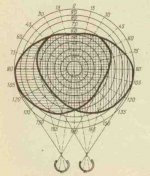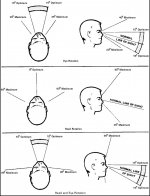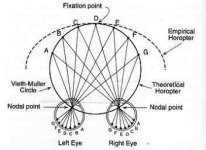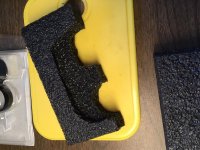You notice a movement in the periphery of your field of view and then automatically will point the sweet spot towards it, you won't keep looking at movement on the edge too long before moving into center of view to id what is moving. So how sharp does the edge need to be? Mainly for the nice sensation of immersion when viewing at something in the middle...
-
Welcome to BirdForum, the internet's largest birding community with thousands of members from all over the world. The forums are dedicated to wild birds, birding, binoculars and equipment and all that goes with it.
Please register for an account to take part in the discussions in the forum, post your pictures in the gallery and more.
You are using an out of date browser. It may not display this or other websites correctly.
You should upgrade or use an alternative browser.
You should upgrade or use an alternative browser.
SF 8x32 v NL Pure 8x42 (1 Viewer)
- Thread starter starforgedape
- Start date
More options
Who Replied?tenex
reality-based
If you like 10x, your first task is to go out and compare some nice brand of 10x32 and 10x42, to see how much you care about the smaller exit pupil. 10x32 isn't very popular, though I've used it for a long time myself; it's all about how tradeoffs work for you. Also for some types of birding at close range (e.g. forest) 8x with larger FOV works better than 10x. So try out some different models and envision your intended use, as best you can. You can't go very wrong with any SF or NL, but some models will end up serving you better than others.I'm not sure myself. I just started getting into birding. I have a 10x42 IS...
Alexis Powell
Natural history enthusiast

You notice a movement in the periphery of your field of view and then automatically will point the sweet spot towards it, you won't keep looking at movement on the edge too long before moving into center of view to id what is moving. So how sharp does the edge need to be? Mainly for the nice sensation of immersion when viewing at something in the middle...
I, as always, disagree. When I am looking at the world without bins and I see something of interest moving outside my central vision, my natural reaction is to quickly rotate my eyes to point them directly at it so that it is at the center of my vision. Afterward, I move my neck etc so my eyes aren't rotated extremely. I like to do the same when looking through bins, so one like the NL with a big flat highly corrected view would be ideal. Bins without a flat view present a blurry view when I quickly rotate my eyes to look at things outside the center of the FOV. They feel unnatural because to get an object in my sharp central vision, I have to keep my eyes fixed down the center of the bin and move the whole bin to center the object. It's as if I can't move my eyes but instead have to keep them locked forward and look around only by moving my neck or rest of my body. Yuck!
--AP
CharleyBird
Well-known member

Apples and bowling balls, yes I know. But I'm just curious as August is coming up, these 2 binos will be released around this time, what are you guys getting? Both perhaps?
I'm not sure myself. I just started getting into birding. I have a 10x42 IS, but I've decided that I will only use it for astronomy.
I know they're different binos completely, thus it will probably be all down to 32 vs 42... But if you were just say shopping for a new bino, which would you go for first?
I'm getting neither.
If I had to choose between these two specifically, sight unseen, I'd choose the 8x42.
See the advice above.
Go try as many binoculars as possible in the shops.
A decade ago I went through at least six shops in and around London that stocked everything from Zen-Ray to Zeiss; ended up surprising myself by purchasing 10x44 Steiner, because at the time, they were right for me as a starter. I still use them often so the time taken was well worth it. They are an all-rounder, like the ubiquitous 8x42.
Until you try, you never truly know whether an instrument will suit you; the weight, the dimensions, your preferred view, and what compromises you will accept for that preferred view.

I had the 8x32 SF on order, mostly for the wide FOV, I cancelled and upgraded the preorder to the NL 8x42.

I had the SF on order and canceled but not to look at the NL either. I know...there are many out there that feel a need and desire to have either. Frankly, they are not worth it. Not that I am, but I can still bird nicely with my $99 Swift Audubon and I have made firm ground in my thinking that these top Alphas are simply not worth the money. Good luck to those that do as I am sure you will enjoy and justify their existence.
Chosun Juan
Given to Fly

"not always. The law of diminishing returns:
you won't notice a wider FOV by 10 feet as much in a wide view as in a narrow view."
That may be true for you but I ALWAYS notice even a 10 foot difference in FOV and it doesn't matter how wide the FOV is and it is significant especially when you have sharper edges on top of the bigger FOV.
Love it when opinions are presented as facts, when the person giving the opinions has never seen the product in person. That takes talent.
Perhaps you are not fully aware of Dennis's background and current capabilities ! :eek!:
https://m.youtube.com/watch?v=0CPJ-AbCsT8
Chosun :gh:
Upgraded? I agree! The reason I chose the NL over the SF is I figure I am going to go big or go home.I had the 8x32 SF on order, mostly for the wide FOV, I cancelled and upgraded the preorder to the NL 8x42.
Last edited:
elkcub
Silicon Valley, California

"not always. The law of diminishing returns:
you won't notice a wider FOV by 10 feet as much in a wide view as in a narrow view."
That may be true for you but I ALWAYS notice even a 10 foot difference in FOV and it doesn't matter how wide the FOV is and it is significant especially when you have sharper edges on top of the bigger FOV.
Dennis,
In order for you to be correct about your abilities, you'd have to defy Weber's Law of just-noticeable differences. So what you're saying is incredulous.
Ed
I don't know anything about any Weber's Law but I know I had a Nikon EDG 8x32 at the same time as a Swarovski 8x32 EL and without a doubt the EL had a bigger FOV. It is called "Mau's Law". It is based on what I see through my own eyes.Dennis,
In order for you to be correct about your abilities, you'd have to defy Weber's Law of just-noticeable differences. So what you're saying is incredulous.
Ed
Last edited:
Torview
Well-known member
Upgraded? I agree! The reason I chose the NL over the SF is I figure I am going to go big or go home.
Dennis I have no brand loyalty and don`t care if one is proclaimed better than the other, but how can anybody declare one better than the other without ever having even touched either ?
Any how I don`t see that these two are in competition with each other anyway, I have invested in a 42mm that works really well for me so no matter how good the NL is I doubt I`ll be buying there, the 32mm SF however has certainly peaked my interest, if it can match the 42mm 99% of the time I`ll probably buy one.
Hi Alexis - Some time ago, i was going to ask you why the off-axis astigmatism complained of in the FL32mm bothered you so much - i guess your post here answers that.I, as always, disagree. When I am looking at the world without bins and I see something of interest moving outside my central vision, my natural reaction is to quickly rotate my eyes to point them directly at it so that it is at the center of my vision. Afterward, I move my neck etc so my eyes aren't rotated extremely. I like to do the same when looking through bins, so one like the NL with a big flat highly corrected view would be ideal. Bins without a flat view present a blurry view when I quickly rotate my eyes to look at things outside the center of the FOV. They feel unnatural because to get an object in my sharp central vision, I have to keep my eyes fixed down the center of the bin and move the whole bin to center the object. It's as if I can't move my eyes but instead have to keep them locked forward and look around only by moving my neck or rest of my body. Yuck!
--AP
Why it doesn't bother me is that i find that pure reflex takes over in my case. If i see movement i may need to examine more closely, i move to centre it. I've tried to do otherwise on occasions, but simply can't - it's just instinct to do it. Kinda like the Eye of Sauron....generally, this move (if the target has been seen in the original FOV) is not going to be excessive.
Interesting though, as various techniques, or acquired behaviour, can extend or reduce the product range that might be most suitable.
I've come within an inch of pre-ordering each but haven't done so. It is appealing to own the best instrument for the job at hand for sure. I'm the worlds worst at wanting to do just that. But in REALITY I have to ask myself how many times did I find a SV 8X32, a SLC 8X42, a FL 7X42, a UVHD+ 7X42, et al lacking in performance in any appreciable way while birding? If I'm honest with myself the answer is ZERO. In fact while the latest/greatest ALWAYS improve in some areas, they will also suffer by comparison in a few other areas. Trust me....I've owned the latest/greatest several times! LOL!
It would be REALLY hard for me to not recommend a Swarovski EL 8X32 Swarovision(SV 8X32). It's literally a THOUSAND DOLLARS less than the NL. Its still probably one of the best birding binoculars out there and only a month or so was the best Swarovski had to offer. Let that sink in for a bit.
It would be REALLY hard for me to not recommend a Swarovski EL 8X32 Swarovision(SV 8X32). It's literally a THOUSAND DOLLARS less than the NL. Its still probably one of the best birding binoculars out there and only a month or so was the best Swarovski had to offer. Let that sink in for a bit.

The only correct answer is get both.
WJC
Well-known member
I don't know anything about any Weber's Law but I know I had a Nikon EDG 8x32 at the same time as a Swarovski 8x32 EL and without a doubt the EL had a bigger FOV. It is called "Mau's Law". It is based on what I see through my own eyes.
Hi Dennis,
By your own admission, you don’t care anything about Weber’s Law, nor the scientific fact that it is IMPOSSIBLE to see axially and marginally—with visual precision—IN THE SAME INSTANT, thus failing to take into account the millisecond spatial and dioptric accommodation of the eye. I think it could be beneficial to the forum if you could give us a list of all the scientifically proven optical realities that are supplanted by your flawless ocular sensitivity, which seems to be based on dollars spent.. :cat:
Bill
"It would be REALLY hard for me to not recommend a Swarovski EL 8X32 Swarovision(SV 8X32). It's literally a THOUSAND DOLLARS less than the NL. Its still probably one of the best birding binoculars out there and only a month or so was the best Swarovski had to offer. Let that sink in for a bit."
It is not the best anymore though. For only another $1K you get a lot of improvements with the NL. A lot bigger FOV with almost 477 feet for the NL versus 423 feet for the EL, smoother focuser in a better location, head rest for better stability, new coatings for better optical performance and better ergonomics with the molded optical tubes. This a big upgrade for the EL's.
It is not the best anymore though. For only another $1K you get a lot of improvements with the NL. A lot bigger FOV with almost 477 feet for the NL versus 423 feet for the EL, smoother focuser in a better location, head rest for better stability, new coatings for better optical performance and better ergonomics with the molded optical tubes. This a big upgrade for the EL's.
Last edited:
WJC
Well-known member
"It would be REALLY hard for me to not recommend a Swarovski EL 8X32 Swarovision(SV 8X32). It's literally a THOUSAND DOLLARS less than the NL. Its still probably one of the best birding binoculars out there and only a month or so was the best Swarovski had to offer. Let that sink in for a bit."
It is not the best anymore though. For only another $1K you get a lot of improvements with the NL. A lot bigger FOV, smoother focus in a better location, head rest for better stability, new coatings for better optical performance and better ergonomics with the molded optical tubes. This a big upgrade for the EL's.
Denny,
Personal preference is without a doubt a winner! :t:
Sweeping statements concerning performance and brushing aside many decades of contributions from respected optical scientists requires a bit more patience and flexibility. :cat:
opticoholic
Well-known member
It is not the best anymore though. For only another $1K you get a lot of improvements with the NL. A lot bigger FOV, smoother focus in a better location, head rest for better stability, new coatings for better optical performance and better ergonomics with the molded optical tubes. This a big upgrade for the EL's.
For me, it's not "only" $1K more. $1K is a LOT more to me.
The magnification and field of view are comparable so in those respects you can compare them. And both have field flattening. I'd say they are apples and oranges, not apples and bowling balls.
As others have said, I can't say for sure before I try binoculars and evaluate the "total experience" which one I prefer.
That said, if they were priced more similarly and I had to pick one without trying it first, I'd probably go with the NL.
Right now the SF 8X32 is at the top of my list because the lighter weight appeals to me in addition to the lower price.
Dave
elkcub
Silicon Valley, California

I, as always, disagree. When I am looking at the world without bins and I see something of interest moving outside my central vision, my natural reaction is to quickly rotate my eyes to point them directly at it so that it is at the center of my vision. Afterward, I move my neck etc so my eyes aren't rotated extremely. I like to do the same when looking through bins, so one like the NL with a big flat highly corrected view would be ideal. Bins without a flat view present a blurry view when I quickly rotate my eyes to look at things outside the center of the FOV. They feel unnatural because to get an object in my sharp central vision, I have to keep my eyes fixed down the center of the bin and move the whole bin to center the object. It's as if I can't move my eyes but instead have to keep them locked forward and look around only by moving my neck or rest of my body. Yuck!
--AP
Alex,
You may always disagree, but you're not alone. It may be noted in the first attachment that the human's two visual fields overlap only 50-60º and that everything outside that range is single vision. A top-tier binocular presents an image to the retina corresponding to its "apparent" field (AFOV), which is typically in the 60-70º range. The 10 degree area from 60-70º (and anything beyond), therefore, is pure monocular vision and can only be seen by one eye. **
The upper panel of the second attachment shows that optimum eye rotation is ±15º, which corresponds to a 30º AFOV. The maximum eye rotation that is possible to center an object of interest is ±35º, but beyond 15º of rotation the view will become increasingly uncomfortable and the head will naturally move to compensate. Not mentioned is the fact that with binoculars when the eye rotates vignetting is unavoidably introduced into the image, which also motivates head motion to center the object of interest.
Generally speaking, head and eye rotation occur simultaneously in a coordinated fashion, although the head lags the eyes because of inertial effects.
However, I do have to disagree about the virtues of flat field optics. The third attachment (more fully explained in the .PDF file) shows what is called the visual horopter, i.e., the locus of points in space that represents corresponding points on the left and right retinas. For an ideal spherical eye these points would fall on a circle, or sphere in 3D, not a straight line or flat plane. Therefore, optics that present linear or planar images will necessarily distort 3D spatial perception, which in my case is extremely objectionable.
Ed
PS. For the 8x, 10x and 12x models the angular AFOVs are 72º, 76º and 78º, respectfully, which explains why the edges are said to "disappear." That's because the outer fields on either side are increasingly beyond the limits of binocular vision.
PPS. I jury rigged a head-rest simulator shown in the last attachment for my Swaro 8x42 SLC-HD. Preliminary conclusion: the headrest will primarily reduce vertical angular motions, which should be beneficial.
Attachments
Last edited:
Similar threads
Users who are viewing this thread
Total: 2 (members: 0, guests: 2)








